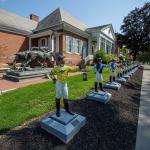
Rodriguez, Paquette, and Mailloux Shined in Ninth Season of Big-Race Showdown

In a complex sport where times are always changing and what is popular today might be forgotten by tomorrow, Claiborne Farm has defied the odds to survive and thrive for more than 100 years. The name resonates with power and is practically synonymous with “quality” and “racing history,” yet Claiborne – despite its legendary status – is far from just a name in the history books. Even after all these years, Claiborne Farm remains a force to be reckoned with, producing champions and graded stakes winners with regularity and standing a top-notch roster of stallions.
The saga of Claiborne Farm actually dates back to the 1800s, when Richard Hancock – a captain in the Confederate Army during the Civil War – started a Thoroughbred breeding farm called Ellerslie in Charlottesville, Va. Richard Hancock’s son, Arthur Boyd Hancock, also developed a serious interest in racing and eventually took over the management of Ellerslie.

Then, in 1910, Arthur Hancock’s wife Nancy inherited her family’s large farm in Kentucky. It was there that the Hancocks established another Thoroughbred enterprise, one that would soon take on the name of Claiborne Farm. And thus the legend began.
To describe the full extent of Arthur Hancock’s contributions to Thoroughbred breeding would require an entire book, yet would still only cover a portion of Claiborne’s lengthy history. Suffice to say, Arthur Hancock made a lasting impact by arranging to import the French classic winner Sir Gallahad III in 1926. The purchase price was so high (estimated at $125,000) that Hancock had to syndicate the stallion and share the expense with three other breeders, but Sir Gallahad III proved to be well worth the trouble. Among his best foals was Gallant Fox, winner of the Triple Crown in 1930.
They say that lightning never strikes twice in the same place, but a decade after importing Sir Gallahad III, Arthur Hancock arranged another syndicate to spend $240,000 on the talented Blenheim II, winner of England’s historic Epsom Derby. Amazingly, Blenheim II would sire Whirlaway, who joined Gallant Fox as a Triple Crown winner when he swept the series in 1941.
Toward the end of the 1940s, illness forced Arthur Hancock to step down from management of Claiborne Farm, and that role passed on to his son, Arthur “Bull” Hancock, Jr. Such a transition of power is bound to come with some trepidation, but if there were any concerns about the younger Hancock’s ability to take over the reins, they were quickly put to rest when Princequillo – a previously unpopular stallion that Bull Hancock had brought to Claiborne in the mid-1940s – became the sire of Hill Prince, the 1950 Preakness Stakes winner and Horse of the Year.
That same year, Bull Hancock arranged to purchase and import the young stallion Nasrullah from England, a move that would have an immeasurable impact on the American Thoroughbred. Nasrullah proved to be a sensational stallion, siring the Horses of the Year Nashua (1955) and Bold Ruler (1957) along with seven other U.S. champions, which helped Nasrullah lead the U.S. sire list in 1955, 1956, 1959, 1960, and 1962.
But the success of Claiborne Farm didn’t stop there. In fact, it only accelerated, arguably reaching a pinnacle when future Hall of Fame racehorses Round Table and Bold Ruler were born at Claiborne on the same day in 1954. In addition to their exploits on the track, Round Table – a son of Princequillo – would become the leading sire of 1972, while Bold Ruler would lead the sire list eight times from 1963 to 1973.
Bull Hancock passed away in 1972 and control of the farm passed to his son Seth Hancock, who has carried on the family legacy ever since. Seth Hancock’s first task was to arrange the syndication of a promising son of Bold Ruler named Secretariat, who had been Horse of the Year as a 2-year-old in 1972. Putting together a historic deal that placed Secretariat’s value at an unprecedented $6.08 million, Seth Hancock had reason to celebrate when Secretariat exceeded all expectations with his record-breaking sweep of the Triple Crown, stamping him as one of the greatest horses of all time.

Secretariat proved reasonably successful as a stallion, siring 1986 Horse of the Year Lady’s Secret and 1988 champion 3-year-old male Risen Star, but Seth Hancock’s greatest contribution to Claiborne Farm history might have come when he brought the up-and-coming stallion Mr. Prospector to Claiborne in 1981. Although far from a superstar as a racehorse, Mr. Prospector would become a legendary stallion, siring champions Gulch and Forty Niner among over 180 stakes winners.
Danzig, another horse that achieved relatively little at the races, would provide another bright spot for Claiborne Farm when he led the U.S. sire list from 1991 through 1993. But as the dynamics of the industry continued to evolve, with a greater emphasis on commercial breeding for profit at auctions, Claiborne Farm gradually slipped from its position at the top of the U.S. breeding industry.
But Claiborne’s story is far from over, and some of its greatest chapters may yet be written. In 2010, the farm celebrated its 100th anniversary with a banner year that saw Blame, a colt they owned and bred with Adele Dilschneider, prevail in the Grade 1 Breeders’ Cup Classic and become a champion. Furthermore, Claiborne’s current stallion roster has grown to include an impressive list of talented racehorses and proven sires, including Kentucky Derby winner Orb, champion sprinter Runhappy, and War Front, whose foals have shown incredible versatility while winning major races at a variety of distance on dirt and turf.
Only time can tell what the next 100 years will bring, but one thing is certain – the name Claiborne Farm will live on forever in racing history.
Fun Facts